Have you ever felt ready to get going on a new piece of work, but you’re feeling completely stuck? You’re experiencing artist’s block – that feeling of desperation when you’re staring at a blank canvas and need some inspiration. You don’t know where to start.
We’ve all been there. But have no fear! Help is at hand.
To help get your creative juices flowing, we’ve enlisted the help of artists Cas Holmes, Nigel Cheney, Emily Jo Gibbs, Sabine Kaner and Sue Stone. In this article, we’ll look at some of their artworks and find out the inspiration behind them.
These artists have generously shared their tips to help you get started on your next artwork. Read on to discover a treasure trove of useful ideas, ranging from research and observation to playing with materials, taking an intuitive approach and allowing your compositions to evolve.
Emily Jo Gibbs
External motivators are a useful way to trigger new work. This might be a brief from a textiles group or community project, a project commission, or a new theme you want to explore. Emily Jo Gibbs made Oil Pastel Sketch in response to ‘Essence’, a 62 Group project brief.
Emily is known for her delicate still life and portraiture work, using layers of coloured silk organza combined with hand stitch. Her compositions have a considered, graphic quality, using appliqué shapes and simple stitches. The layered organza shapes allow her to create depth, adding life to her subjects.
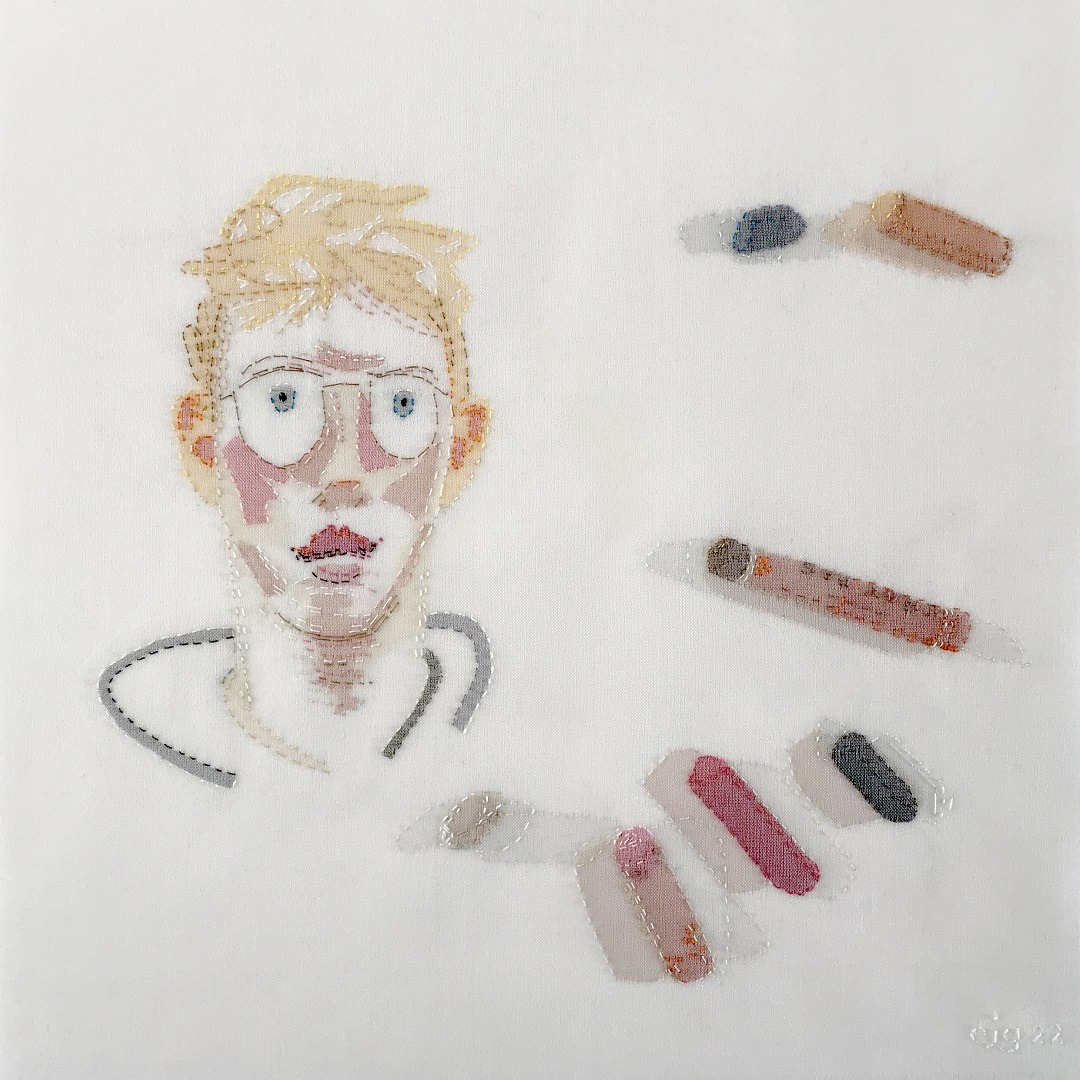
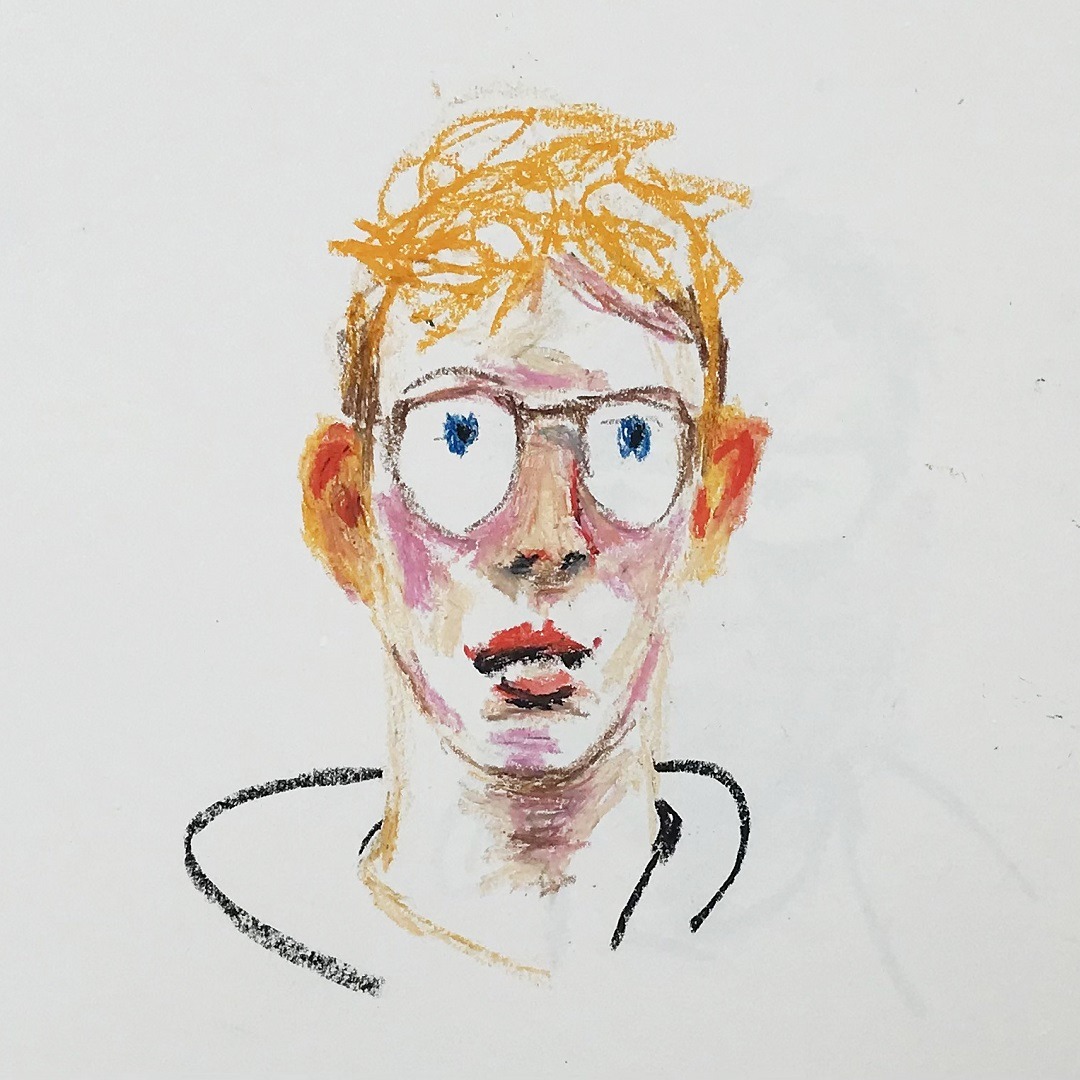
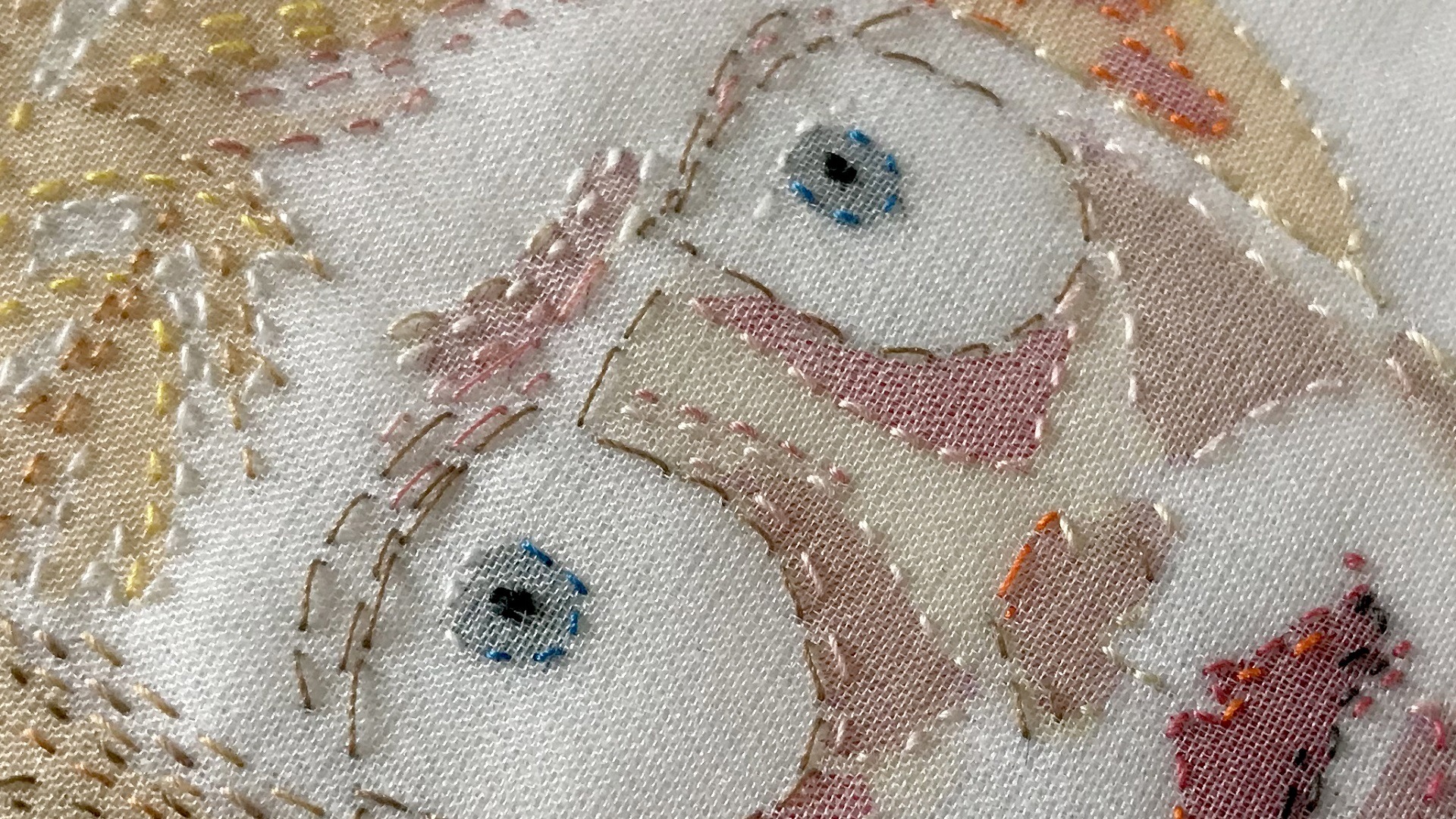
Optical illusions in stitch
Increasingly, Emily has become more interested in making work from her own drawings, whereas in the past she always based her work on photographic references.
Emily made an oil pastel drawing of her son during lockdown but hadn’t done anything with it, other than take a reference photograph with the oil pastels still resting on the sketchbook page. When she was thinking about the essence of her practice for the 62 Group brief, this image seemed to be the perfect culmination of all the things that excited her about her art practice.
‘It combines all the elements that I enjoy: a portrait of a loved one, hand cut overlapping pieces of silk organza, colourful stab stitches, shadows, and the surprise element of trompe l’oeil.’
The photograph of the drawn image alongside the drawing materials themselves, the oil pastels, became the template for her composition.
Emily cut out pieces of coloured organza to correspond with the marks she had drawn. She really enjoyed making the shadows of the pastels – knowing that organza lends itself perfectly to create the properties of shade. Despite this, she found the pastels and their shadows to be the trickiest part of the composition. Although they are relatively simple in shape, many layered pieces of different coloured organza were needed to create the realistic effect.
Tips from Emily for getting started
- Try working with translucent fabrics, like silk organza, taking time to explore their unique properties. If you want to cut out crisp, accurate shapes, pin the organza to a paper pattern and cut out the paper and fabric together.
- Play with an organic approach to your work. Cut out some shapes, perhaps related to a drawing you’ve made or simply draw around an object that you have to hand. Build a picture using these cut shapes. Where they overlap, new colours and tones will emerge.
Read about Emily’s alternative portraits in Emily Jo Gibbs: Stitching the tools of the trade.
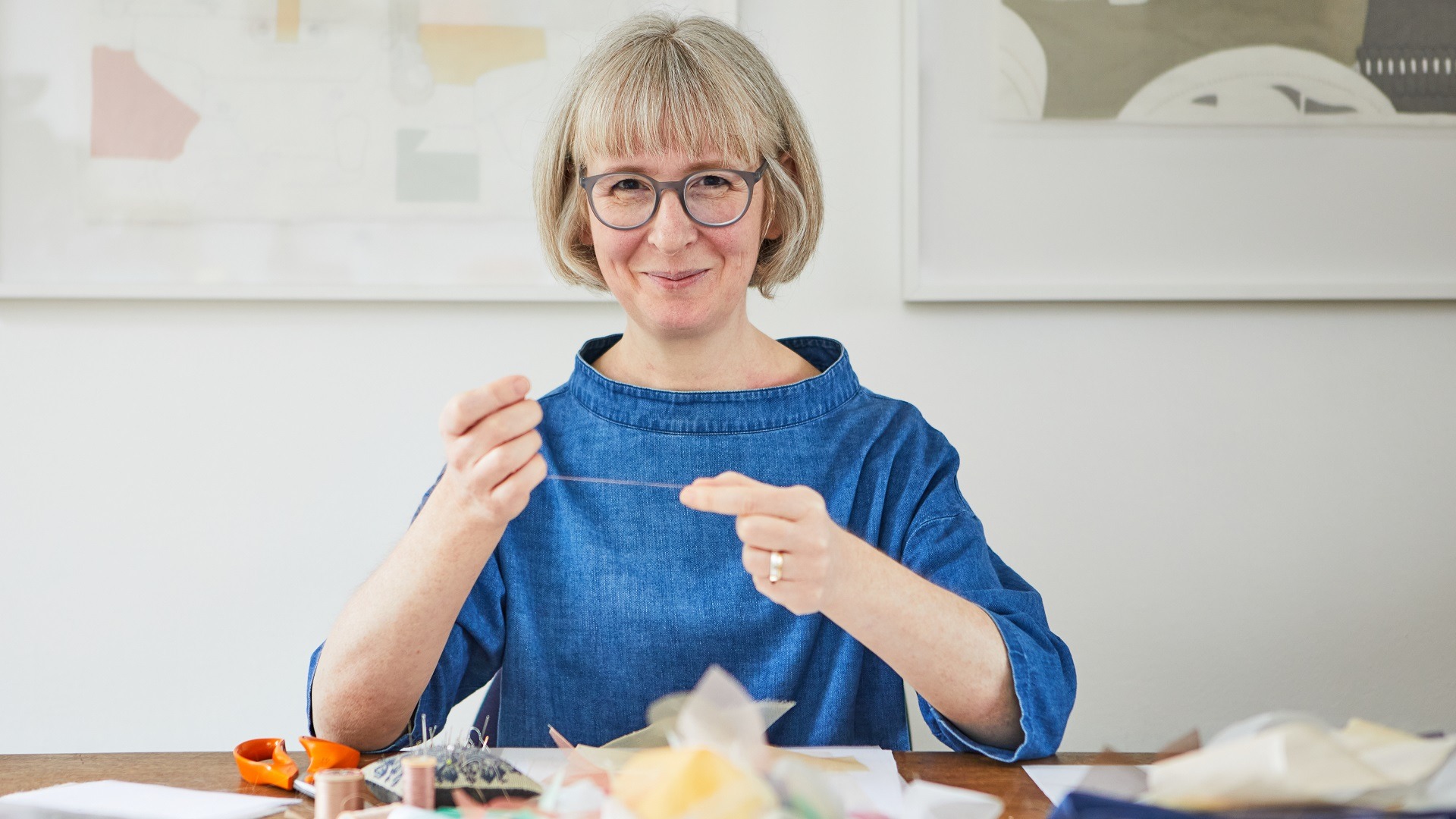
Emily Jo Gibbs is based in London, UK. Her exhibition The Boat Builders was shown at St Barbe Museum and Gallery, Lymington (2022). Emily is a member of The 62 Group of Textile Artists and a Fellow of the Royal Society of Arts. Her work is featured in The Victoria and Albert Museum, The Crafts Council Collection and the Museum of Fine Art in Houston, TX (USA).
Artist website: emilyjogibbs.co.uk
Facebook: facebook.com/emilyjogibbs
Instagram: @emilyjogibbs
Sabine Kaner
A long-time lover of symbolism, Sabine Kaner uses symbols and colour to tell stories and express emotions, explore heritage, identity and mental health.
The Long Long Life of the Tree is a perfect example of Sabine’s warm, tactile combinations of recycled textiles, wool and felt, combined with printed and painted backgrounds. Layers of materials are connected using hand stitch with thick textured threads, a slow process which allows her to work through memories and knit together a narrative into a tapestry-like form.
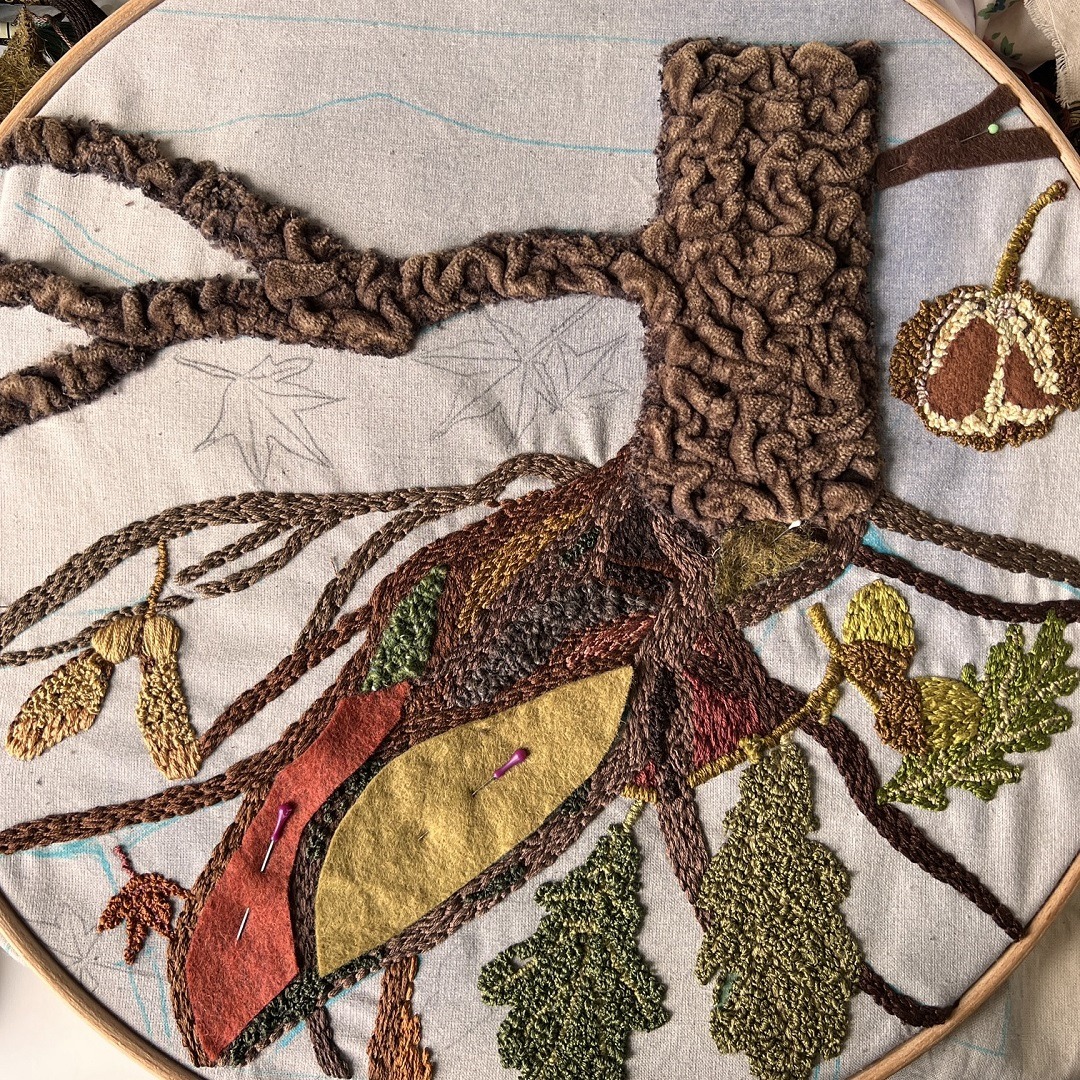
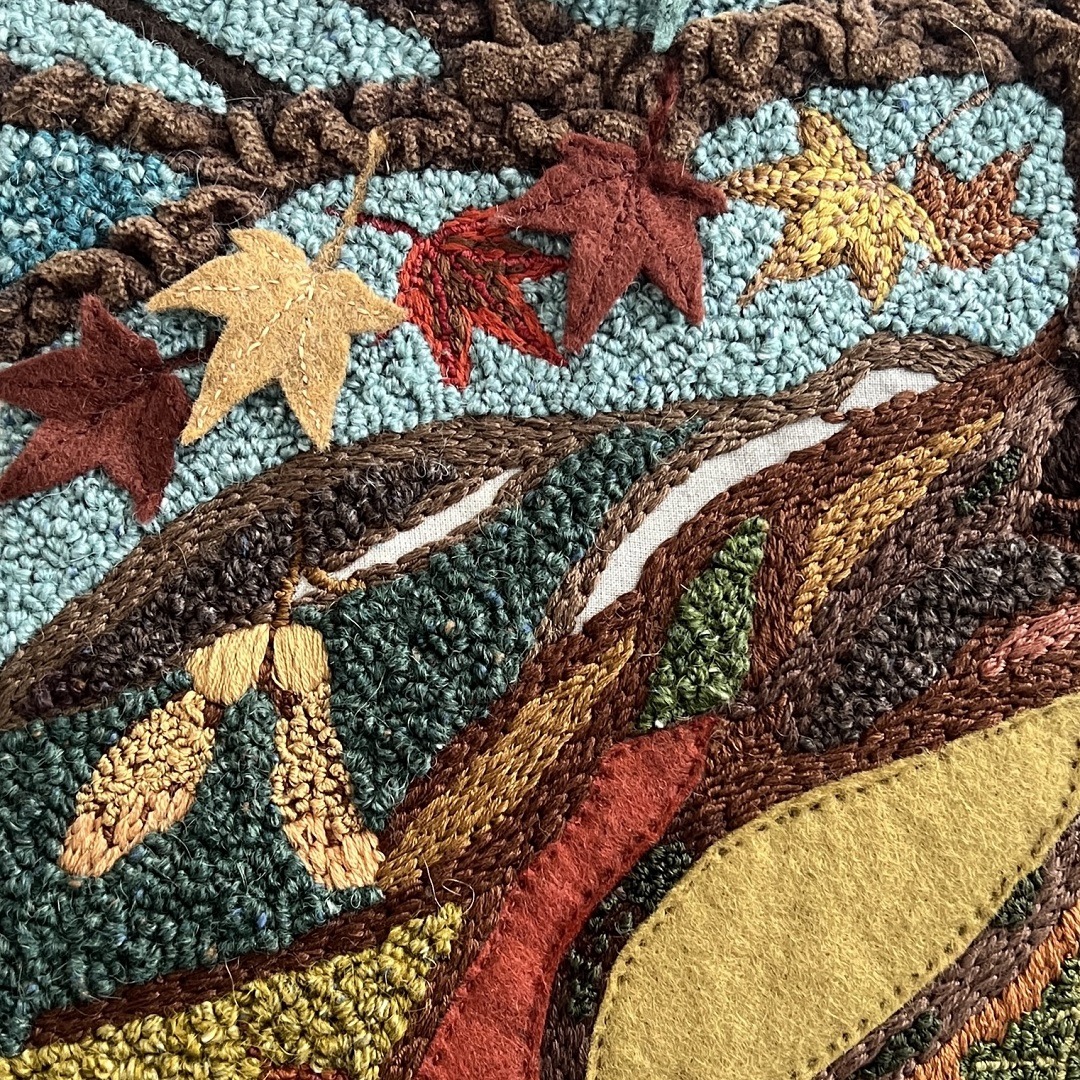
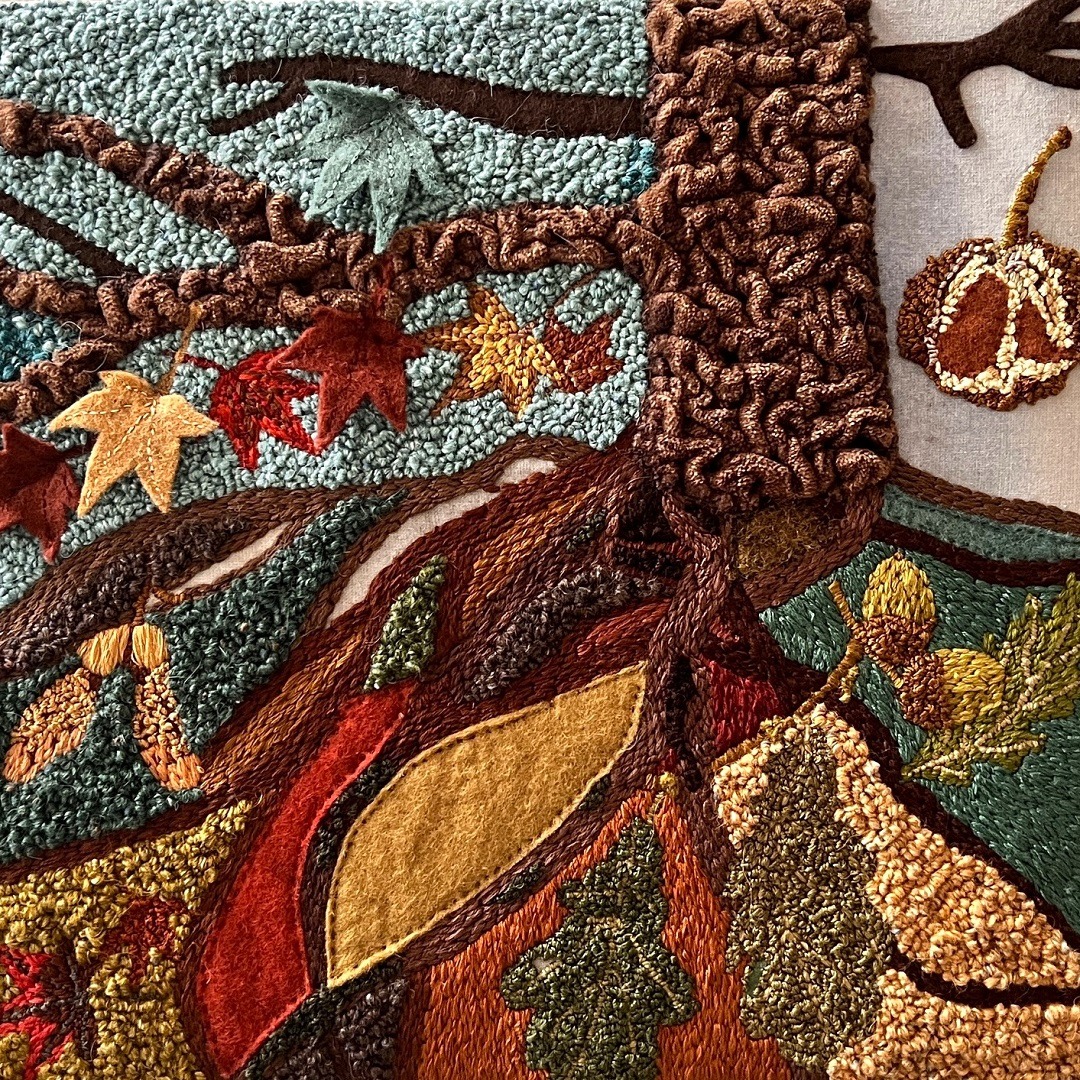
The evolution of a tree
In 2022, Sabine was commissioned to create an artwork for the music director of a well-known choral society. The inspiration was a new piece of music inspired by the crucial role of trees as part of the earth’s ecosystem.
With this in mind, and following discussions with the person who commissioned her, Sabine started to do some research and make initial sketches. She went for walks in the countryside, taking reference photos and looking at the way various trees were growing. Then she dug out other photographs she had taken previously. She gathered reference images showing tree bark, acorns and chestnuts, and intertwined, moss-covered roots reaching out through layers of fallen leaves.
Sabine then started to plan the composition by reviewing her fabric supplies.
‘I collected together some felt and repurposed fabric. I used an old cushion cover with a strong texture to represent the tree bark. This became the centre of the work, around which I could build up the image.‘
To create the work, Sabine painted the background cotton fabric with diluted watercolour paint. On this base, she attached the ‘tree bark’ fabric. She nestled pieces of appliquéd felt between the roots of the tree, and completed the design with embroidered images of leaves and seeds using thick, textured, looping threads.
Tips from Sabine for getting started
- A piece of fabric can often spark off ideas and inspiration. Sabine starts by sorting through scraps of fabrics in her collection and picking out the colours and textures that she’s drawn to.
- Create a moodboard and play with combinations of materials – lay out your fabric pieces and imagine how they might fit with your ideas, photos, sketches or a project brief. Move them around and add different threads to see how they work together.
- Allow the work time to breathe and evolve. Transfer some of your chosen images and shapes onto a plain fabric and use the fabric scraps to build up the picture. Work gradually, adding hand stitch to slowly connect the work together.
Read about Sabine’s work in Sabine Kaner: Stitching life experiences.
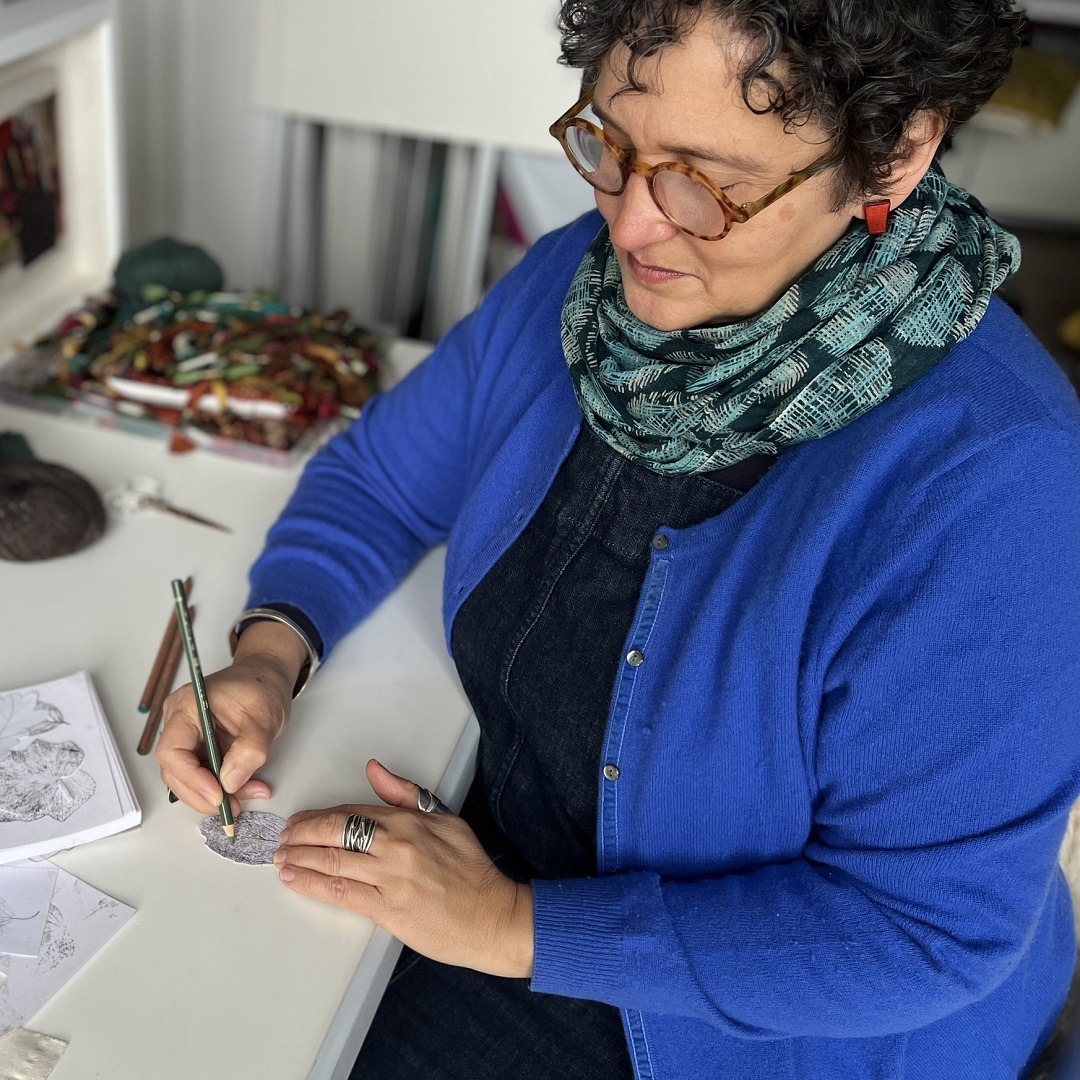
Sabine Kaner’s Hand-Stitched Stories exhibition was held at Museum in the Park, Stroud (2022). Other solo exhibitions were held at Stapleford Granary (2021-22) and 78 Derngate, Northampton (2021). She has also exhibited with @SEAS Brighton to celebrate the Windrush Generation’s contributions to the UK and @wellspace in London to coincide with Mental Health Awareness Day. Sabine is a member of the artist group @Outsidein.
Artist website: sabinekaner.com
Facebook: facebook.com/sabinekaner
Instagram: @sabinemake
Sue Stone
Sue Stone is an avid photographer, and she uses her collection of photos to help her create textile stories. Her compositions are often a mixture of fact and fiction, combining real and invented people and places, and often merging the past with the present. Sue’s mixed media and stitched work explores imagined journeys and creates narratives about family, history and life.
A major source of inspiration for Sue is her family photo album, but she also takes hundreds of photos of the details, textures and patterns that surround her. She is drawn to the overlooked details like the textures and patterns found on buildings or in the street, as well as brickwork, signs and colourful splashes of bold, but often transient, graffiti art. By including these details in her work, she brings to life the locations she depicts.
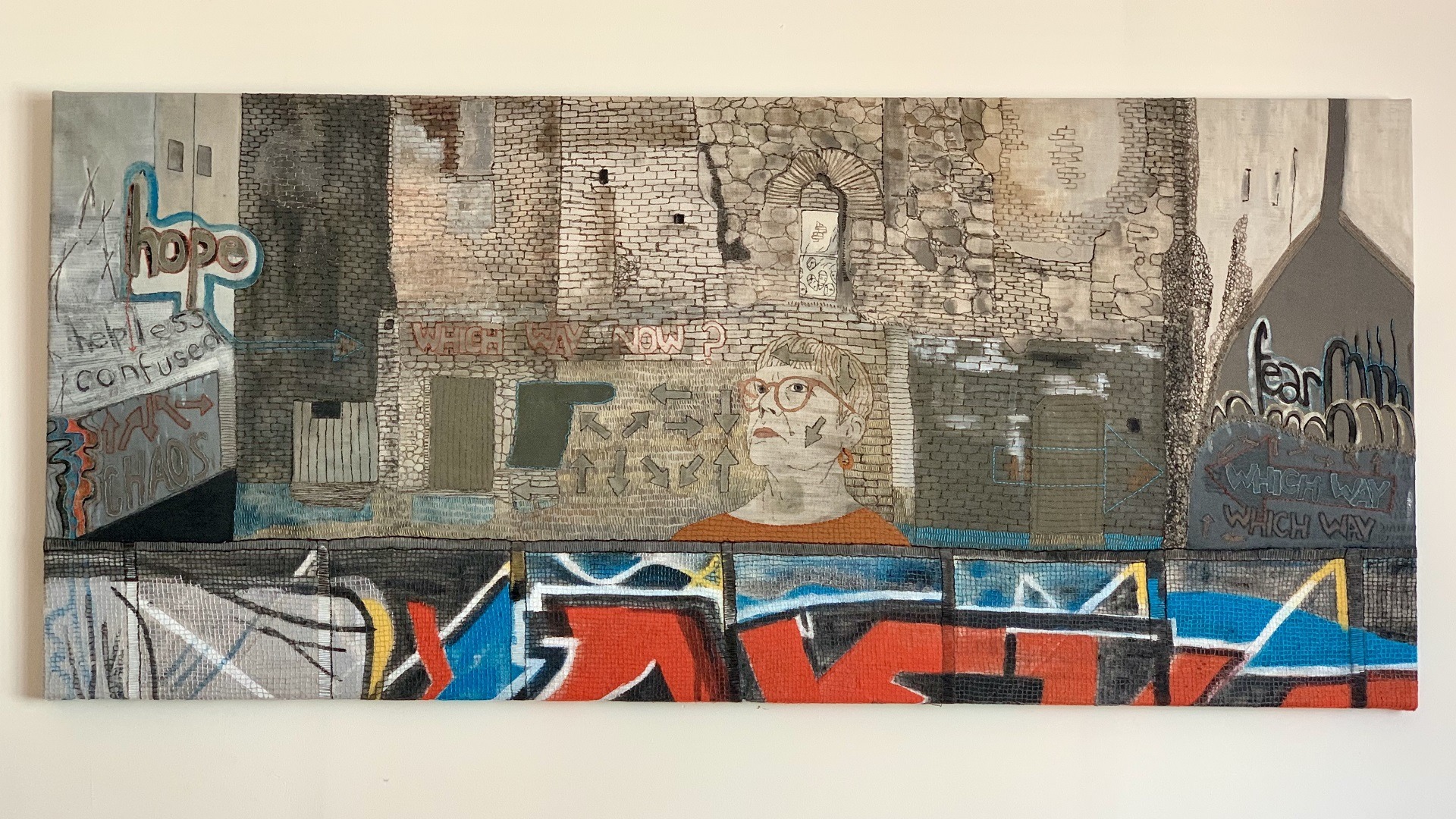
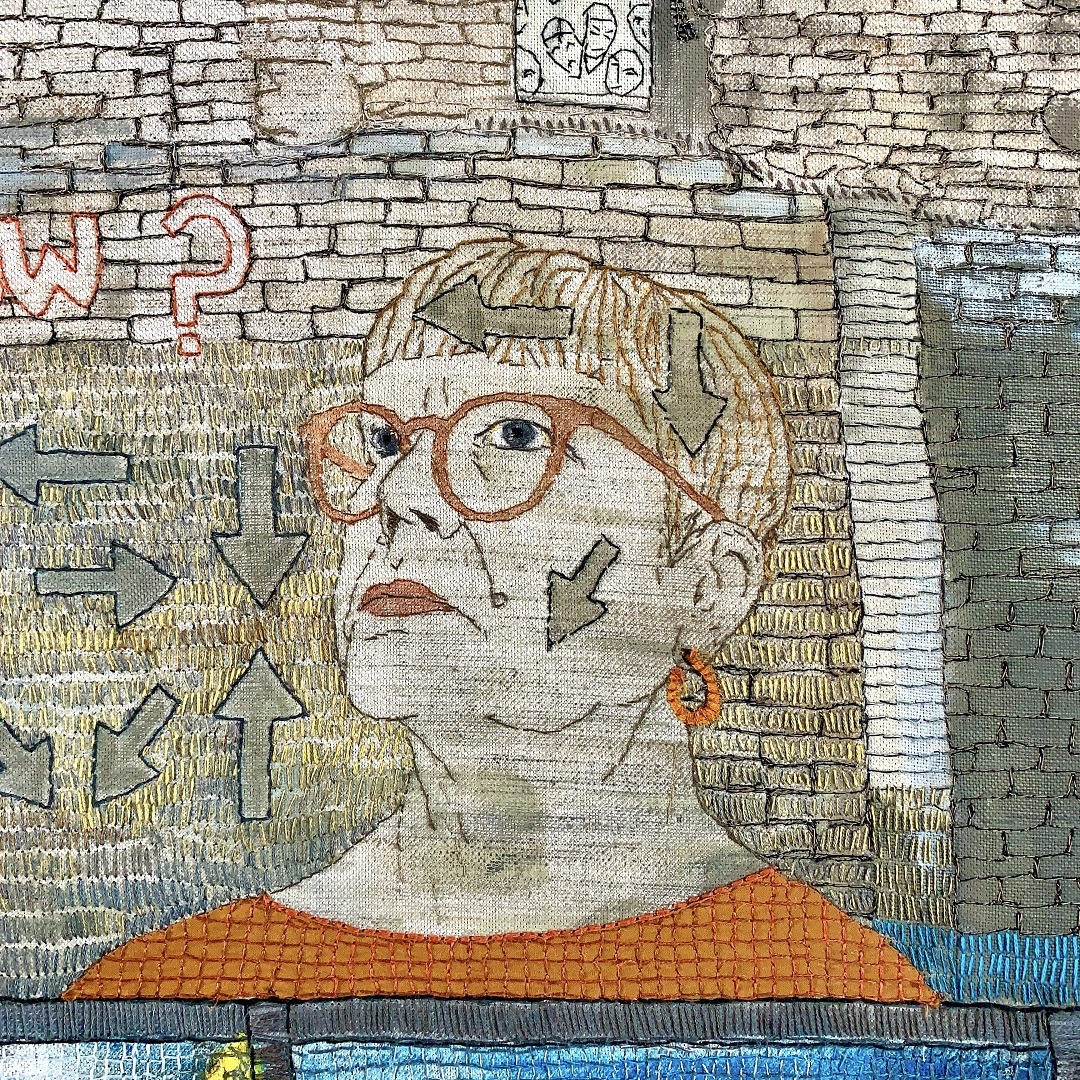
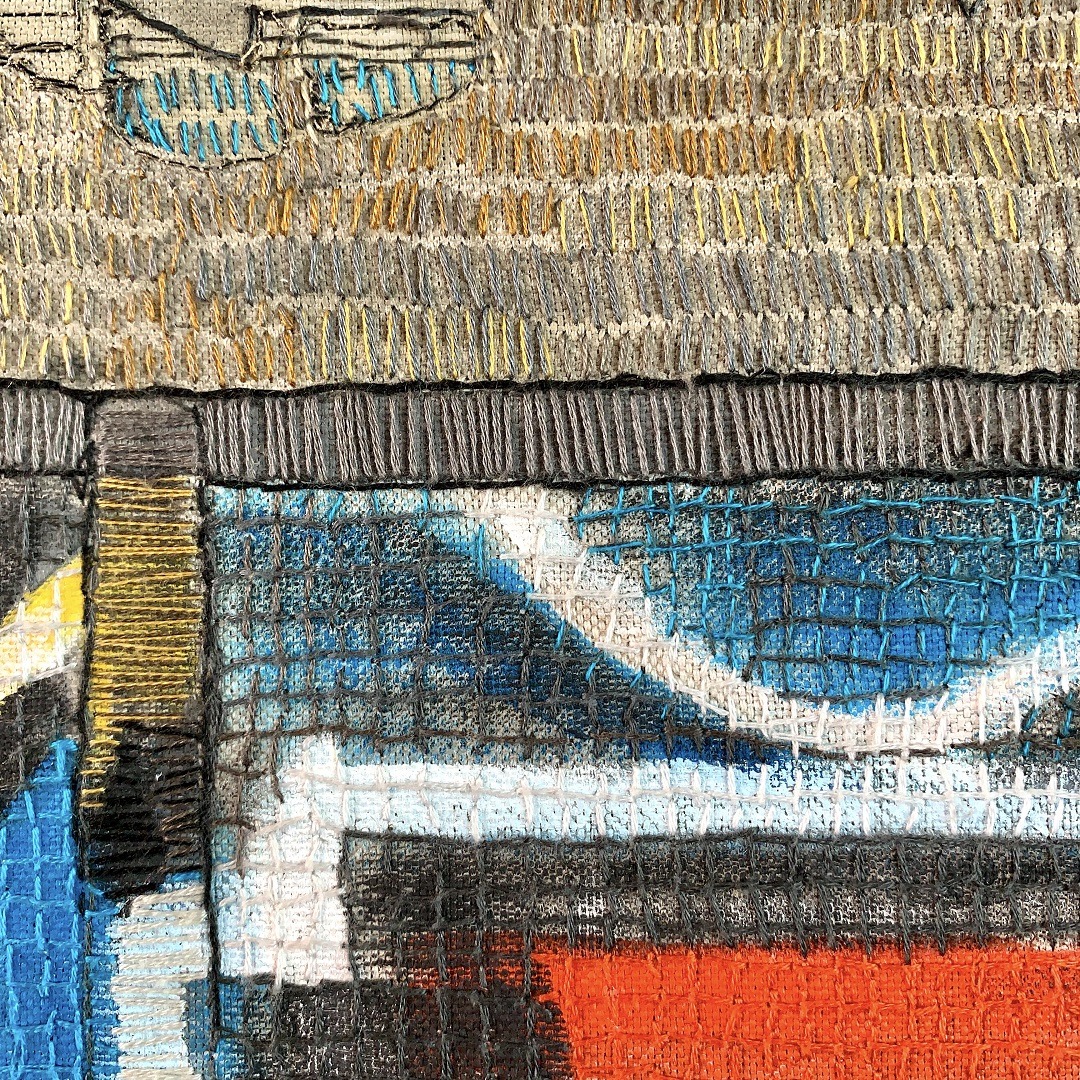
An expression of inner turmoil
Which Way Now? was made in 2020 during the pandemic, when Madrid was in the news as it was one of the places hard hit by the virus. Sue visited this beautiful, vibrant place for the first time in autumn 2019 when her work was included in the World Textile Association’s Invited Artists Salon exhibition, The Essence of Textile. She fell in love with the city during this idyllic trip.
Sue’s starting point was a photo she’d taken of an isolated crumbling and ruined building in Madrid, with graffiti on its walls and on the fence surrounding it.
When she first started it, Sue wasn’t sure which direction the artwork was going. She just needed to keep her hands busy at the time. For this work, she adopted a new, immediate way of working – drawing freehand with a Pilot Frixion pen, directly onto the fabric.
‘Amid the confusion and chaos created by the Covid-19 virus, there were occasional glimpses of hope, swiftly followed by fear and dread. The slow hand stitching of the graffitied fence in the foreground proved to be therapeutic.’
Stitching gave Sue some quiet thinking time, and she realised that the crumbling building was a reflection of her state of mind – the conversation she was having with herself in a time of turmoil – and this led to a depiction of herself within this crumbling and confused environment, with flashes of hope hidden within.
Tips from Sue for getting started
- Never dismiss any of your ideas. Jot them all down in a notebook and they can become a reference library for you to dip into for inspiration if you get stuck.
- Take photos of anything and everything around you. If something catches your attention, photograph it. Make sure you organise your photo collection, perhaps into themes, so you can locate images easily when you need to.
- Simplify your starting images into a simple line drawing. This will stop you from getting overwhelmed by detail at the outset – you can always add more detail later.
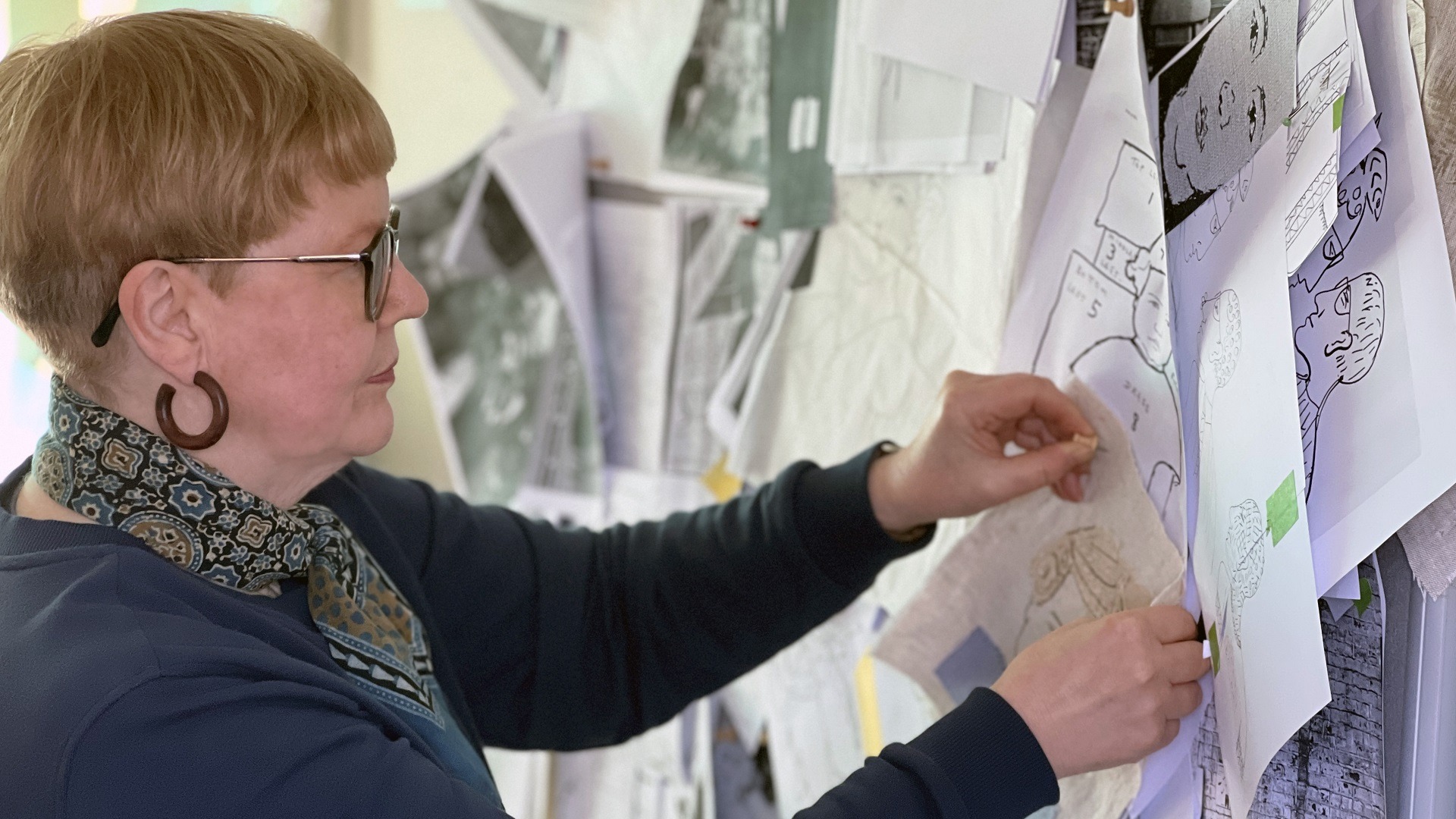
Discover more about how Sue’s work comes together in Sue Stone: Where top textile artists look for inspiration.
Sue Stone is based in the UK. Her work has been exhibited worldwide, including at her solo show Shifts and Allusions, at The Hub, Sleaford (2023), at the 12th From Lausanne to Beijing International Fibre Art Biennial Exhibition (2022), and as part of the 62 Group’s exhibition at the Knitting & Stitching Show (2022). She is a member of the 62 Group of Textile Artists, and a Fellow of the Society of Designer Craftsmen.
Artist website: womanwithafish.com
Facebook: facebook.com/suestone.womanwithafish
Instagram: @womanwithafish
Nigel Cheney
The sculptural textile work Corporal William Holman grew from the curiosity Nigel Cheney had about his great grandfather, and what it meant to serve your country in the First World War.
Corporal William Holman was born in 1882 and died at the age of 35 in France, making the ultimate sacrifice in the First World War. The artwork was first created for Nigel Cheney’s solo show, Decorated, at the Hub in Sleaford, in 2017, and has since undergone many reincarnations.
Starting all his projects with a period of in-depth study, Nigel likes to collect a mountain of source materials. As part of this process, he gathers objects, archival images, family documents, ephemera and associated literature, poems or novels. And he finds that eBay is the perfect place to collect items linked to his theme.
Nigel began by exploring what little he knew of Corporal William Holman’s life, and the widow and children he left behind. Immersive research helps him to decide what lens to examine his theme through, and in this case, it soon became apparent that he was interested in memory.
‘All my research implied that his widow, the incredible Nellie Holman, did not dwell in the past. The photograph of him in uniform was always in pride of place on the mantle, even though her sadness was not dwelt on and certainly never spoken about.’
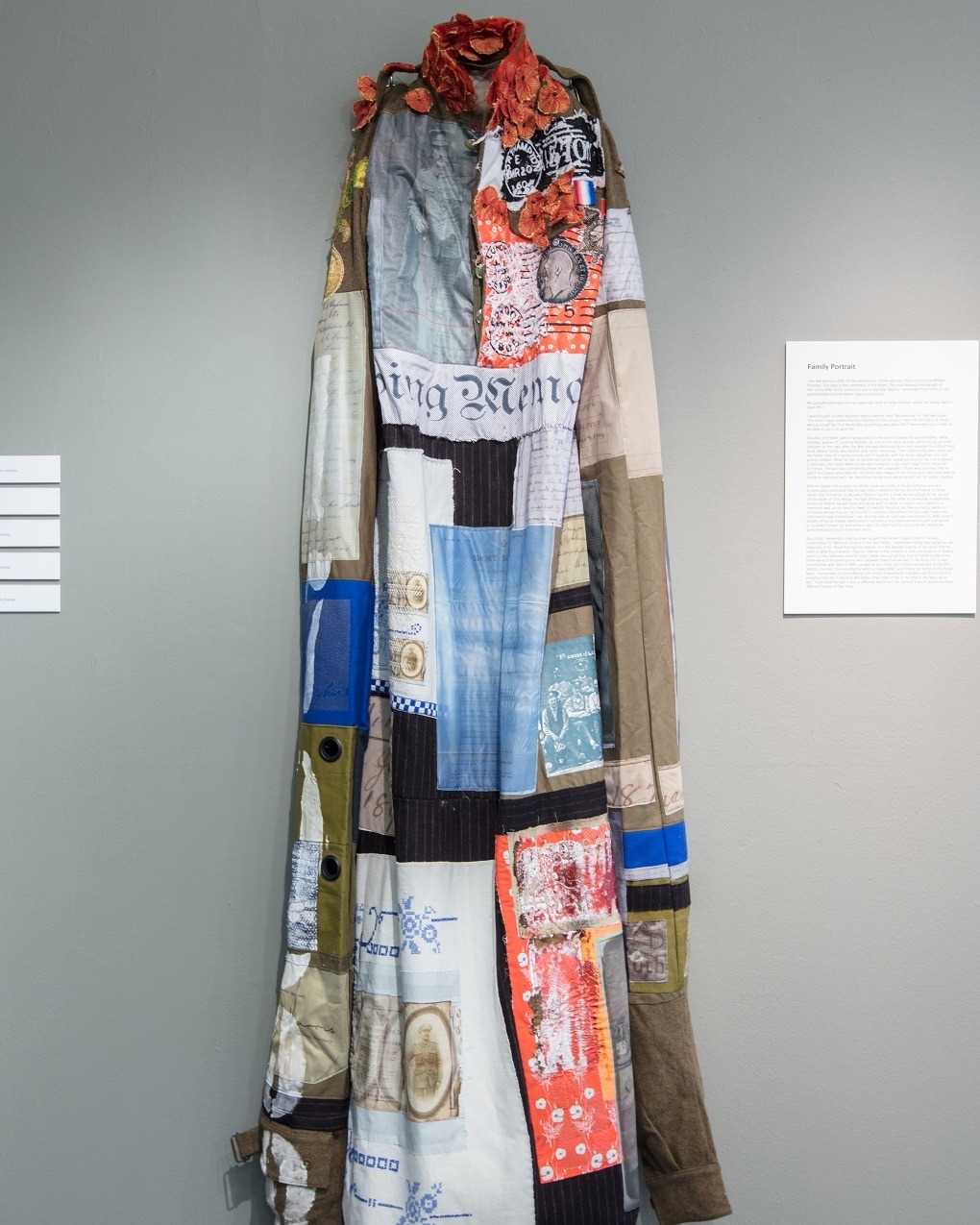
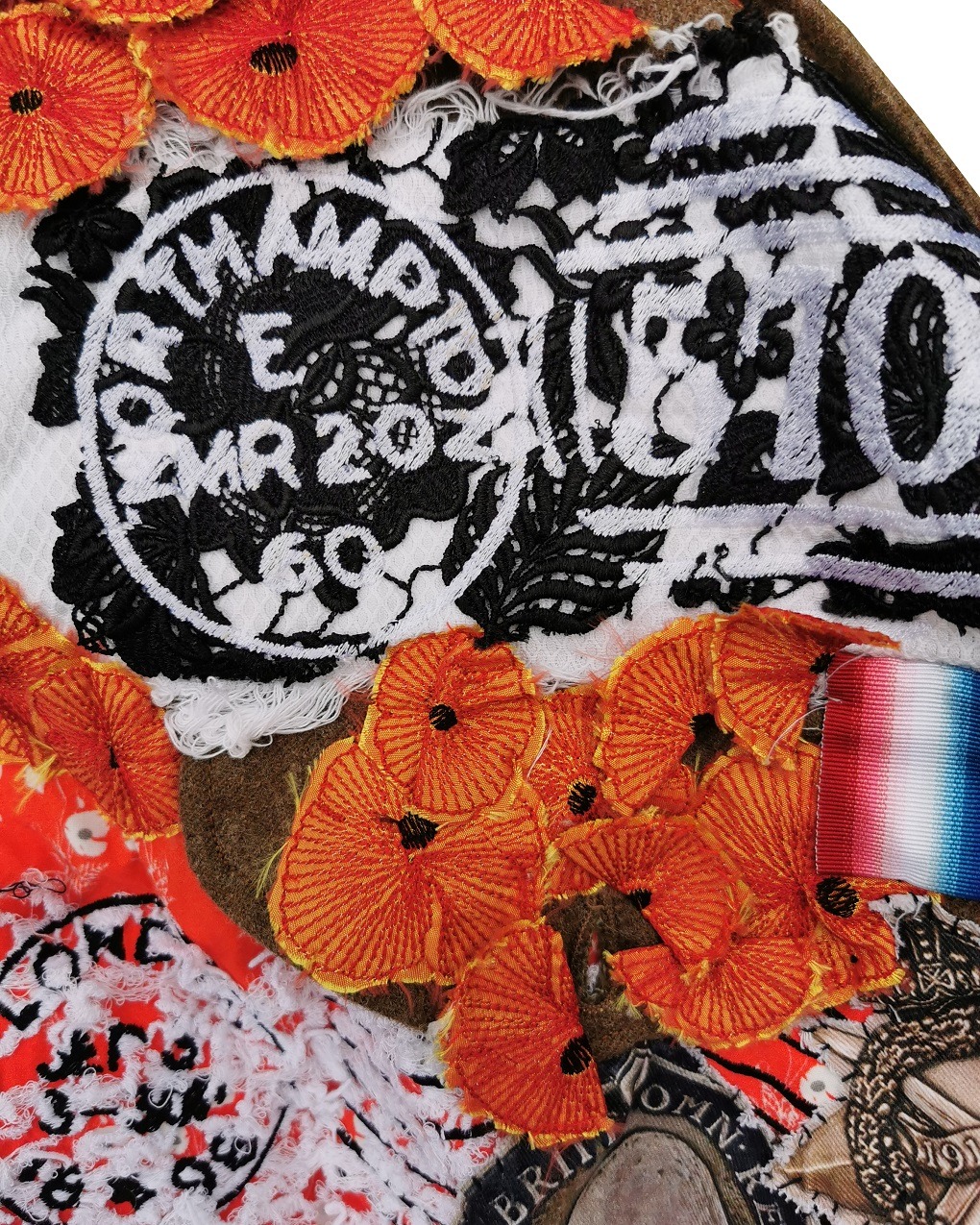
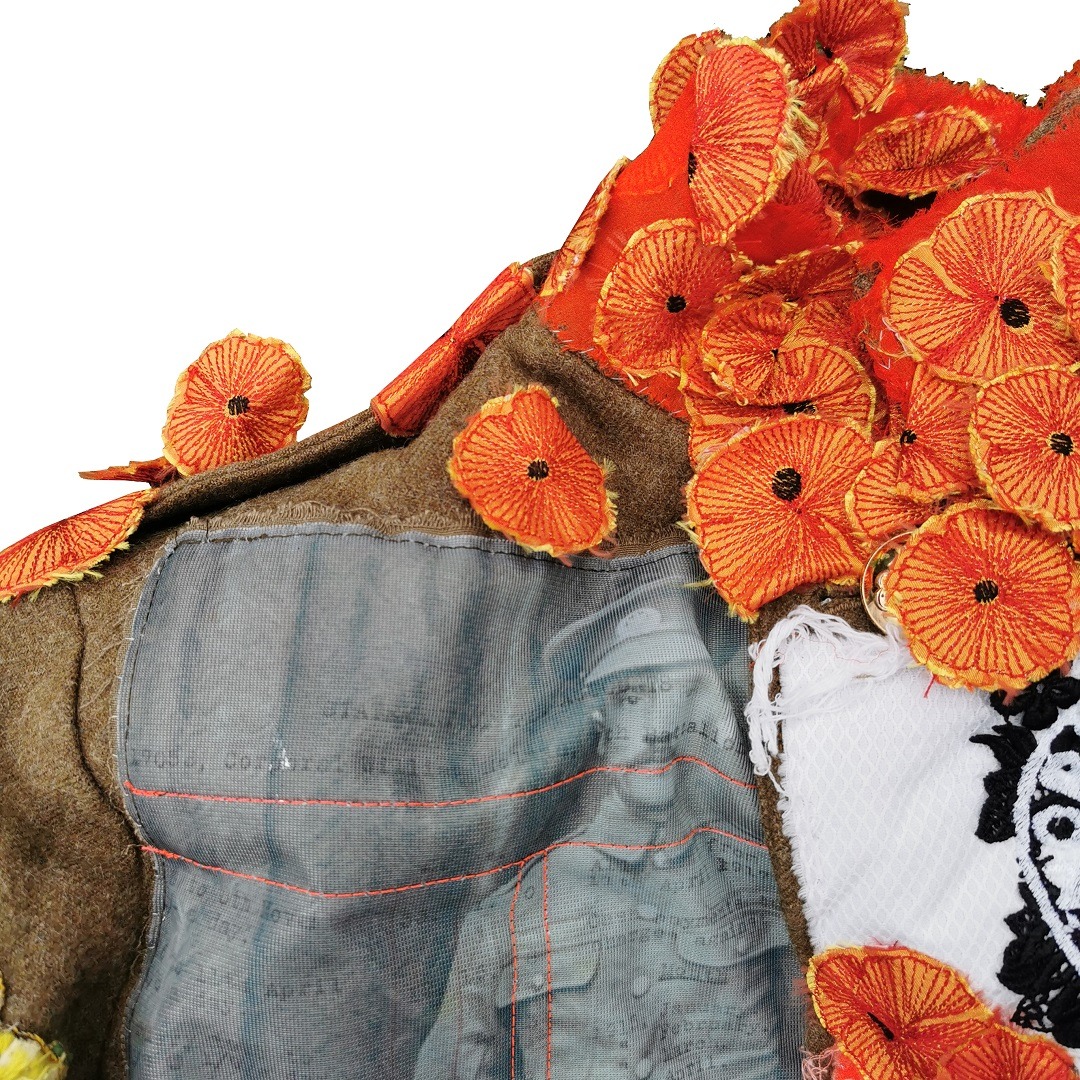
Research, collect, collage
Nigel began by digitally recording military records, the few surviving family photos, and images of medals, medal ribbons and correspondence. Then he collaged paper prints and scans, allowing an intuitive response to overtake historical accuracy.
Interested by the residual and collective grief left behind after so much loss, and how small scraps of history become distorted and incomplete as time passes, Nigel realised that most of what he knew about his great grandfather was factually incorrect. He didn’t understand what the medals signified or how William Holman’s life story could be contextualised amidst his regiment or his hometown, Market Harborough.
‘For me, memory isn’t linear but there are elements that repeat like a musical refrain, often at the most inopportune moments.’
Nigel enjoys experimenting with a variety of techniques including drawing, digital printing and low tech image transfer methods. But fabric and stitch allow him to be at his most expressive, so he manipulated the collected imagery using a computer and printed them onto fabric, ready to stitch into using hand stitch and digital stitch techniques. He had no interest in using genuine uniforms from the First World War, so he sourced and dissected new ex-army stock uniforms. The difference in cut and construction became a test – would the viewers be aware of the historical inaccuracies?
He had gathered the ingredients. Now it became a matter of moving the composition’s elements around to achieve a balance.
‘I felt the making needed to be somewhat crude – function came foremost over couture techniques.’
While seeming like a straightforward task, fighting with a small domestic sewing machine to put back together the parts of the uniform, along with the stitched fragments, became exhausting.
Once the work was assembled, the final task was to stencil Corporal William Holman’s service number over all the precious elements of this ‘body bag’. A uniform is not a delicate piece of cloth, and Nigel wanted to show that the scars that deface the depictions of nostalgia are as important as the medals that decorate them.
Tips from Nigel for getting started
- Working with memories is powerful. Just looking at a family photo or touching a favourite old garment can be overwhelming. So be kind to yourself. Sometimes you can work around a problem – are there similar second-hand fabrics that remind you of something, without having to work with a precious heirloom?
- It’s vital to set a lens through which to view your work. What is your intention? Does it need to be factually correct? Or are you expressing your own interpretation? Decide who the work is for and how you want those related to it, biologically or emotionally, to respond to it. It can be tricky to work with personal information, so be inclusive in how you gather information. You may be able to use official historical documents, data and text within your narratives while taking care not to publicise the data of living people. But if you are using archive sources, get permission to include them in your work.
- Colour can be the most effective communicator. It can help set the tone for what you want to convey. If the work isn’t how you expected – whether delightful, sombre, brooding, playful or nostalgic – then try changing the colour balance.
- Above all, make mistakes. This is the true path to creativity. And sometimes cutting up your work can be the best approach. Nigel has never found a ‘disastrous sample’ that couldn’t be improved with some pruning!
To find out more about his practice, read Nigel Cheney’s interview.
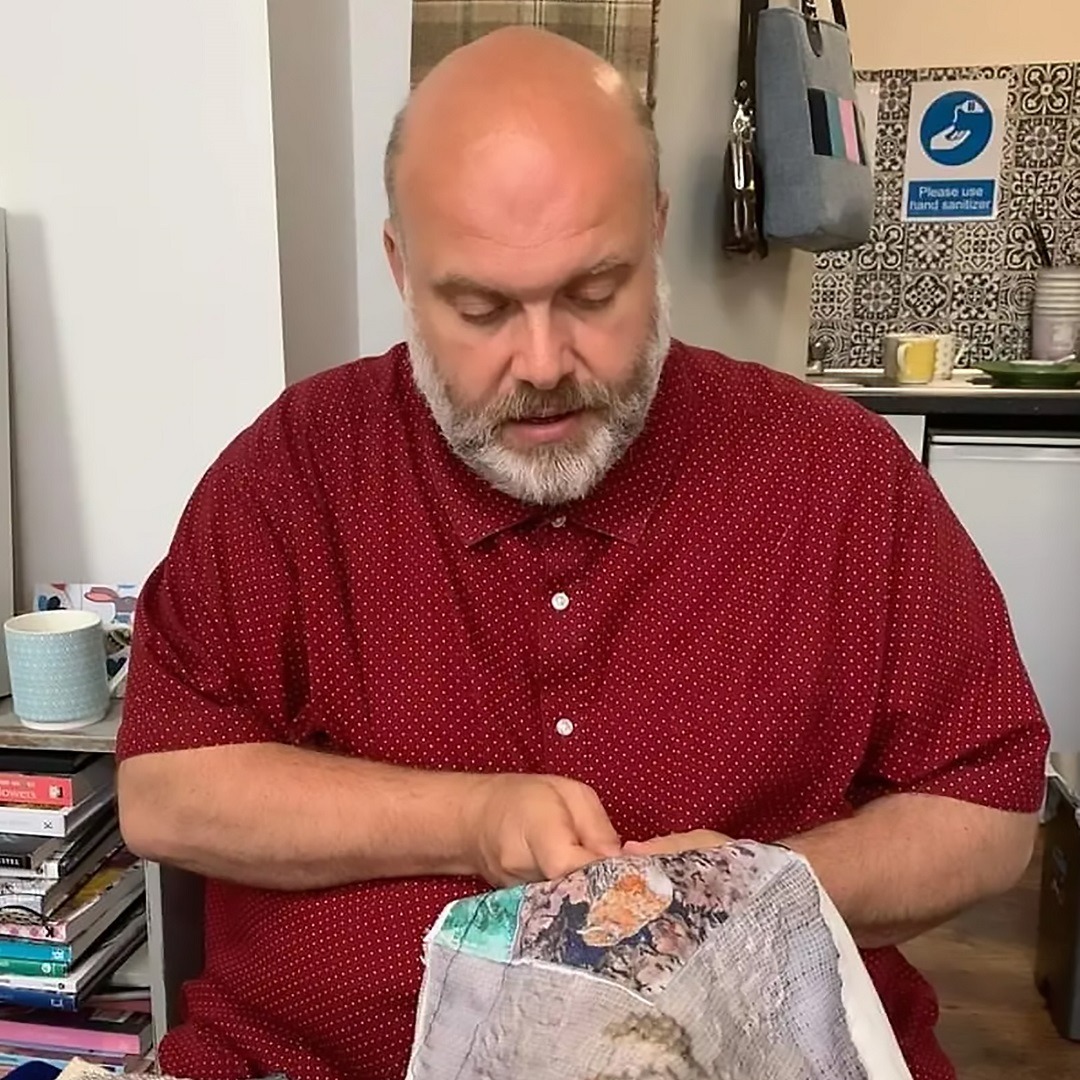
Nigel Cheney is an embroiderer based in Market Harborough, Leicestershire, UK. He was a finalist in the Hand and Lock Embroidery Prize, Open Textile Art category, 2022. He held the position of Lecturer in Embroidered Textiles at National College of Art and Design, Ireland, for over 20 years before retiring to live in his native Harborough.
Artist website: nigelcheney.com
Facebook: facebook.com/nigel.cheney
Instagram: @nigelcheney
Cas Holmes
In her work, Cas Holmes seeks to capture the memory or atmosphere of a place or a moment. She gathers materials, drawings and written references during her travels. And by interacting with these collections, she can evolve the meanings and stories behind her work.
Travel has always been an important part of her creative inspiration, however, just as Cas was starting to move again after the pandemic lockdowns, her partner, Derek, had a stroke.
She had to find a new balance, as both artist and carer, and so she began to adapt her work to a smaller landscape – her home surroundings. However, her process remained the same: Cas still sketches and makes notes to record her travels, even within this smaller environment. In the quieter times, she stitches or spends an hour marking and layering her collections of cloth and paper.
During this time, Cas has gained a new-found respect for the often-overlooked aspects of everyday life, like the edges of the footpath on her daily walks in the park, and the places where the home and garden meet the outside world.
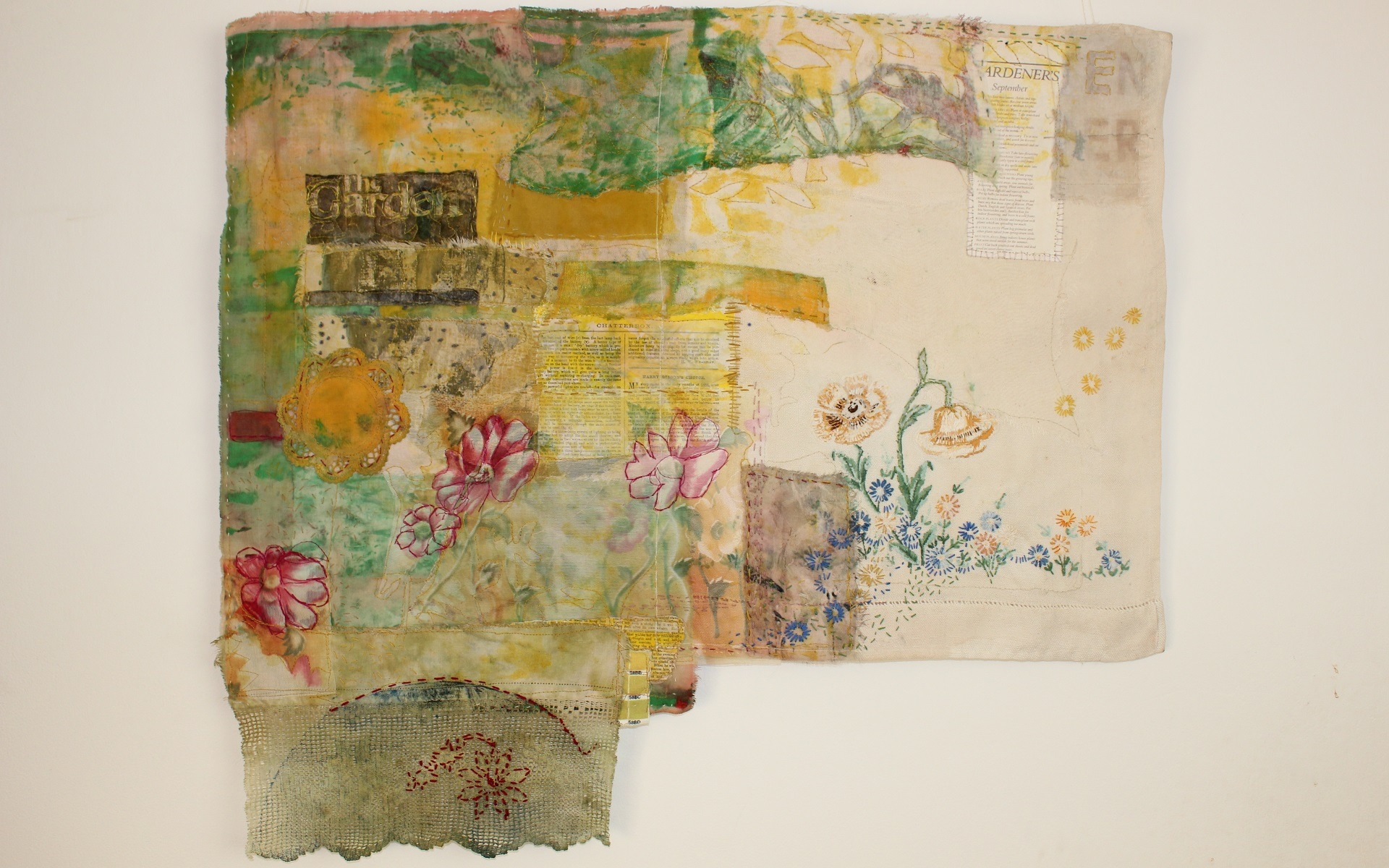
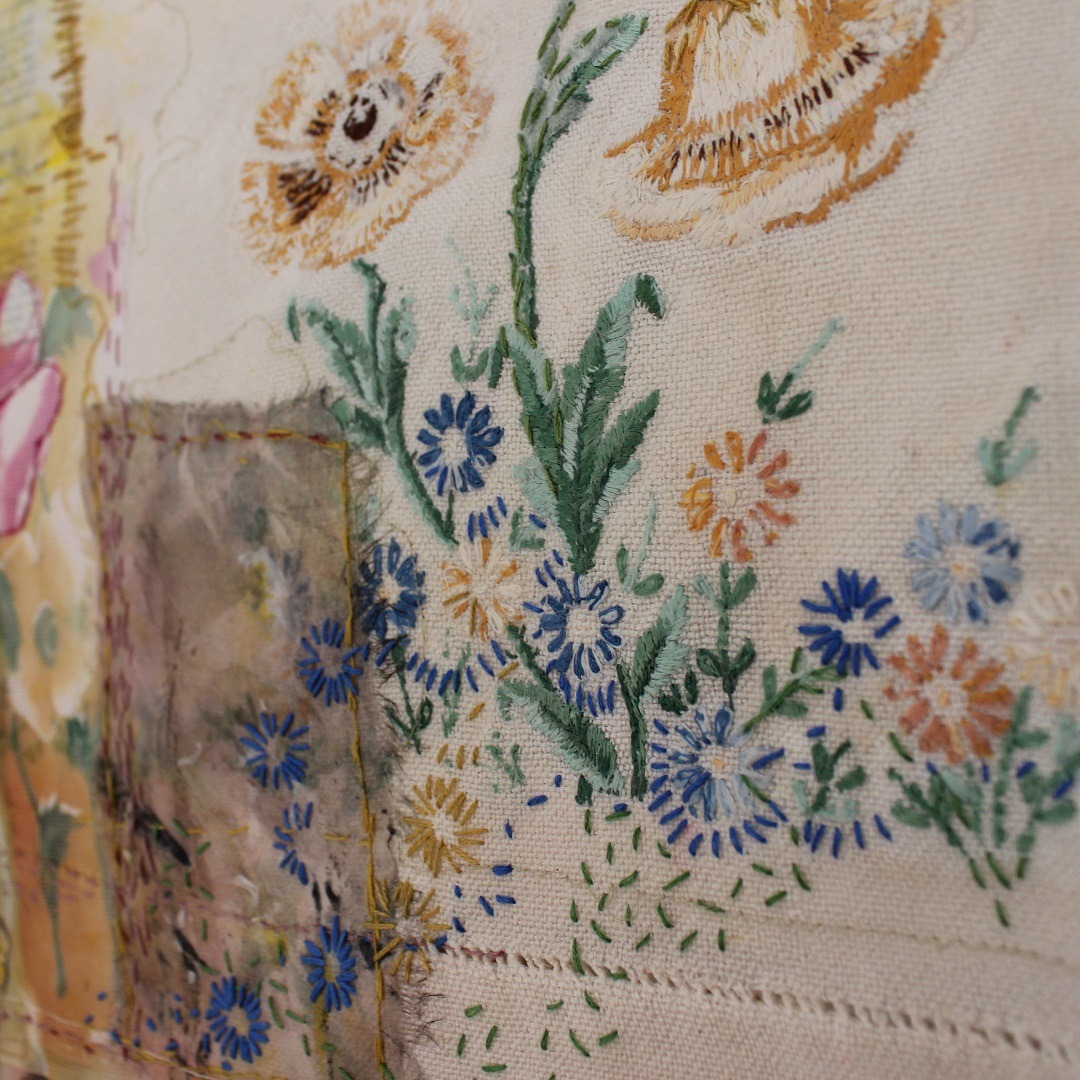
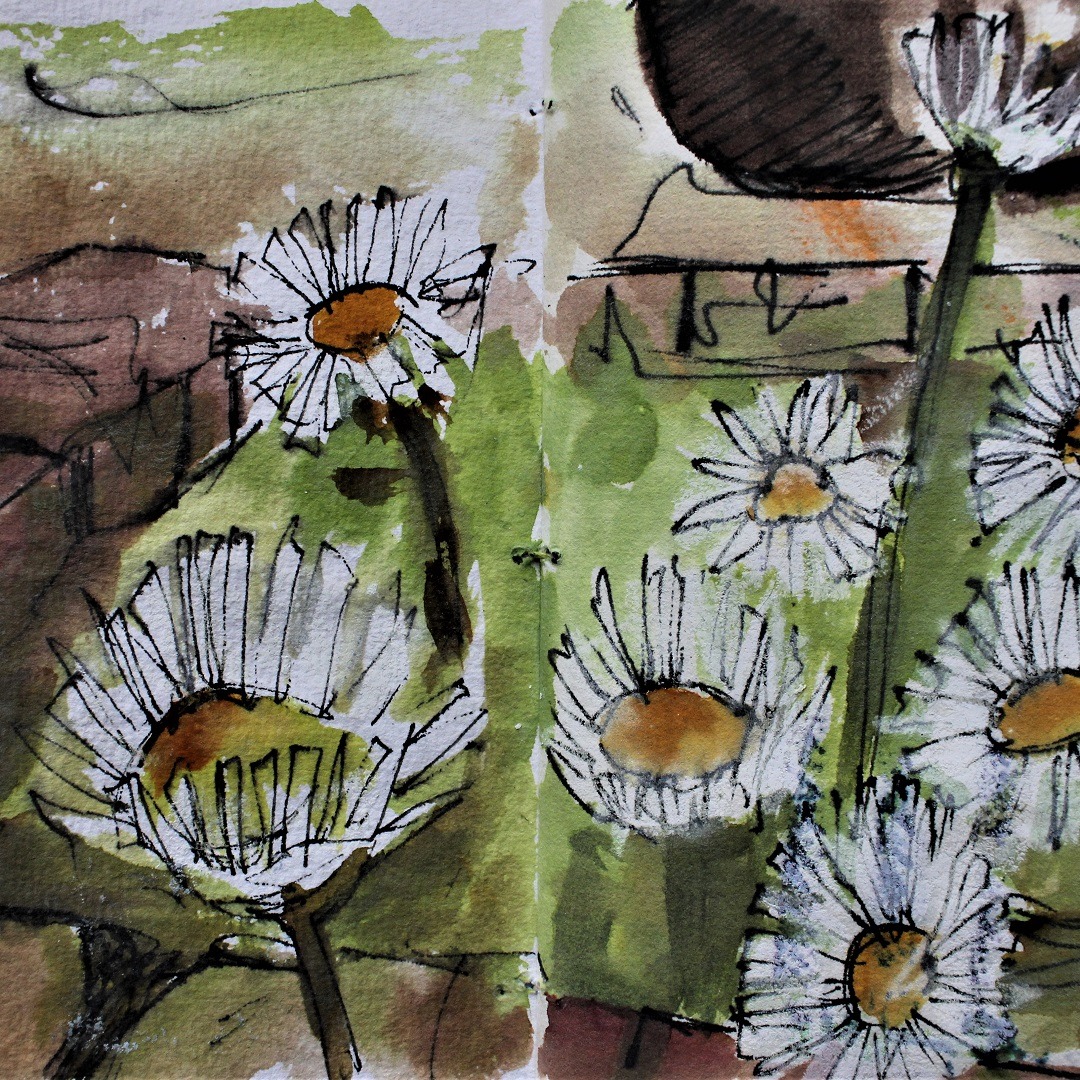
The Garden
The Garden is one of a series of pieces made during her transition from watcher to worker in the garden. She took the time to witness the garden in all its glory and began to notice the gardening activities that needed her attention. These observations became the source of inspiration for her artwork.
‘In that lovely summer of 2022, I sat and sketched in the sunshine as we healed and found a new way of being in the garden together. As Derek began to recover he talked about the things that needed to be done in the garden (and those I should leave alone).’
Cas often uses the methods of deconstruction and reconstruction, which have become a vital part of her creative process both physically and mentally. Working on two or three projects at once, she used offcuts from old gardening books, a section from a tray cloth and colour image transfers of the plants growing in her garden.
Her work has always been informed by the simple things, like drawing, talking, observing, and then threading these connections with stitch. Cas finds poetic solace in the minutiae of the everyday things she explores, connecting hand, eye and mind through sketch, paint and stitch.
‘When I look at The Garden it takes me back to that healing moment in time. Exploring and recording a local patch of land, a garden or a small space in depth can be a rich resource for your investigations.’
Tips from Cas for getting started
- Take the time to record the atmosphere of a place – draw, make notes, focus and be present
- Observe the small details. Try using a magnifier or the zoom function on your camera or smartphone.
- Make a collection of ‘finds’ from the place. Perhaps you could record the changes you observe through the year. Create a storyboard or a diary of the things you discover, and note down your thoughts including the visual qualities, colours and shapes.
For more about Cas’ work, and how she used found and vintage items read Cas Holmes: Found objects in textile art.
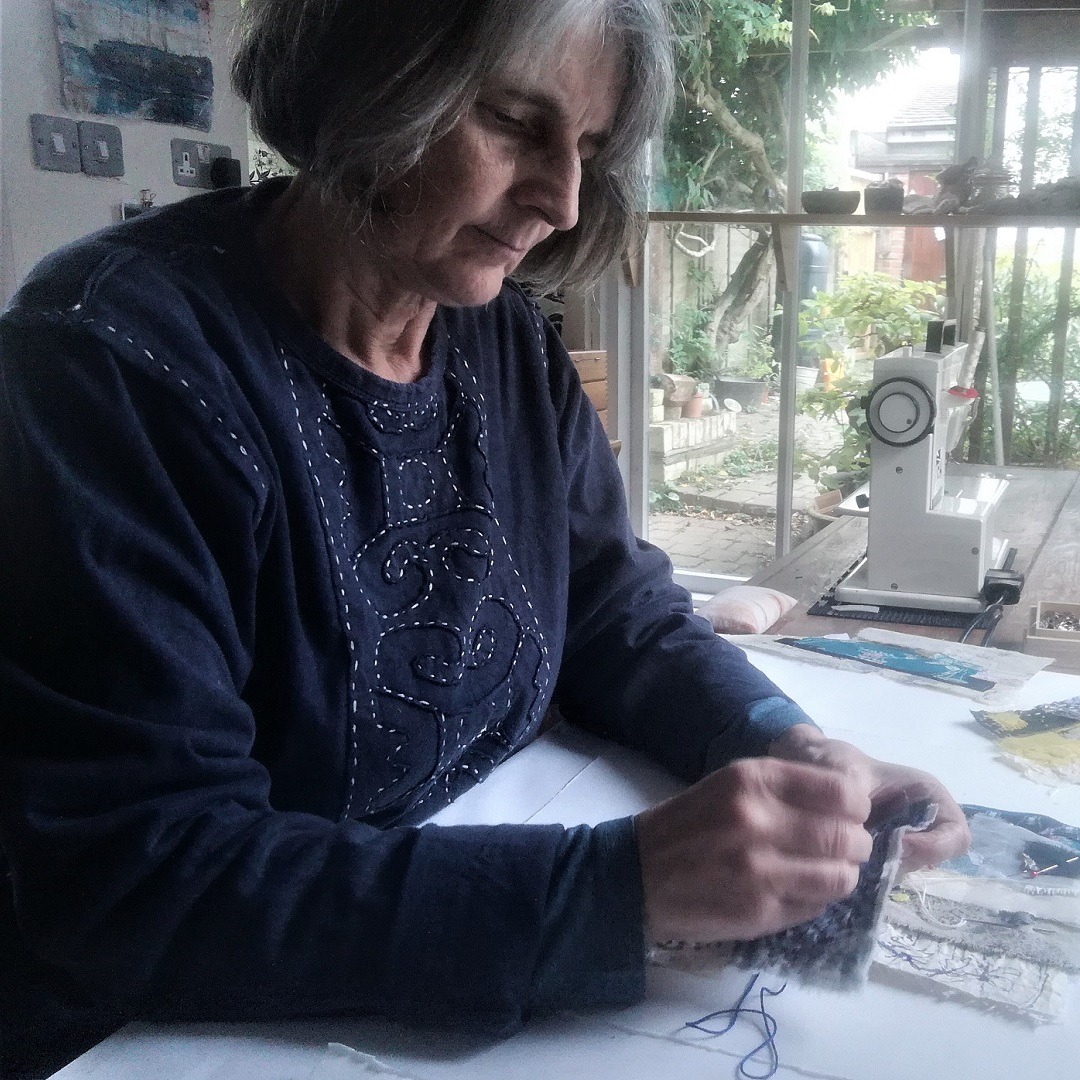
Cas Holmes is based in Kent, UK. She is the author of several Batsford books, including Embroidering the Everyday (2021), and a member of Art Textiles: Made in Britain textile group and the Society for Embroidered Work. Her exhibitions include Gypsy Maker 4: Places, Spaces, Traces, which was exhibited in Belgium and toured the UK in 2020-23.
Artist website: www.casholmes.co.uk
Facebook: facebook.com/casholmestextiles
Instagram: @casholmestextiles
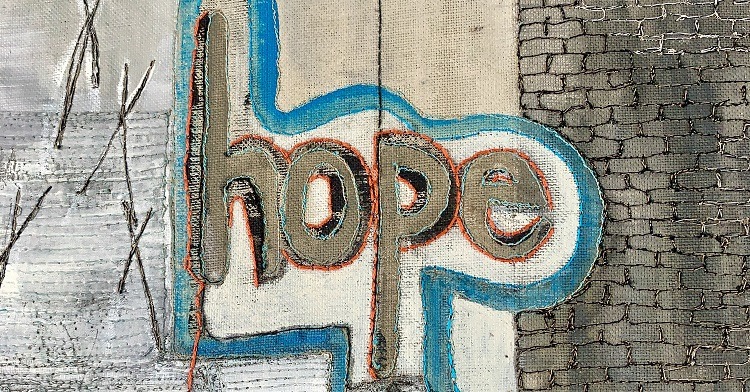
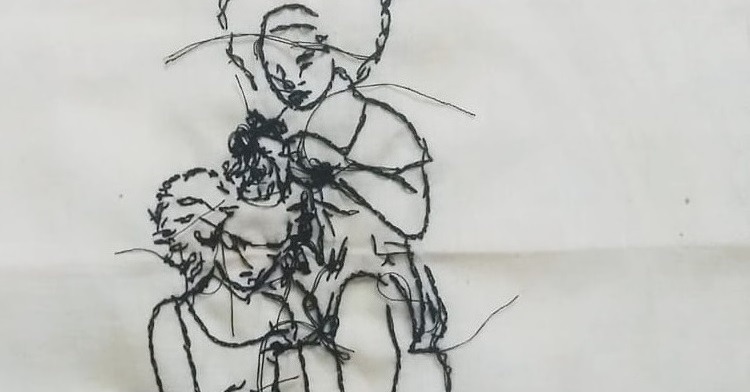
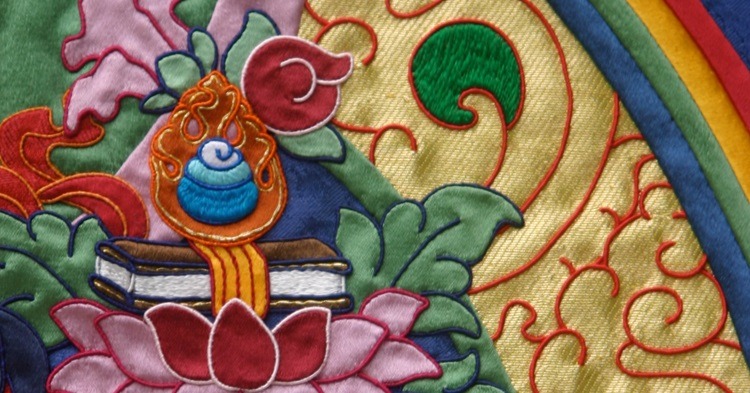
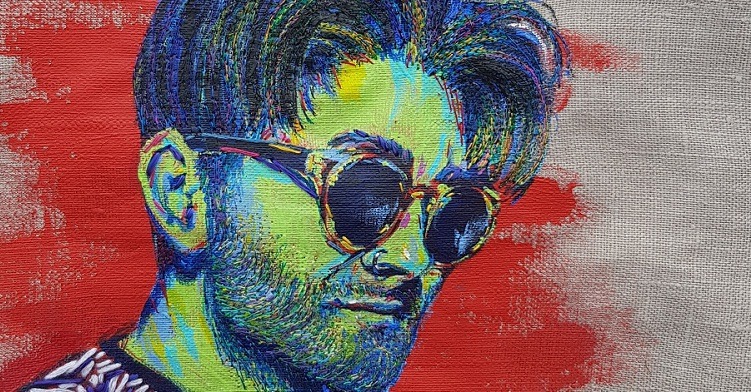
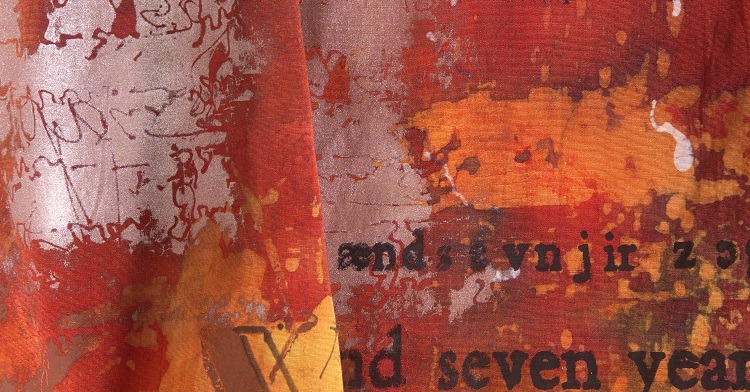
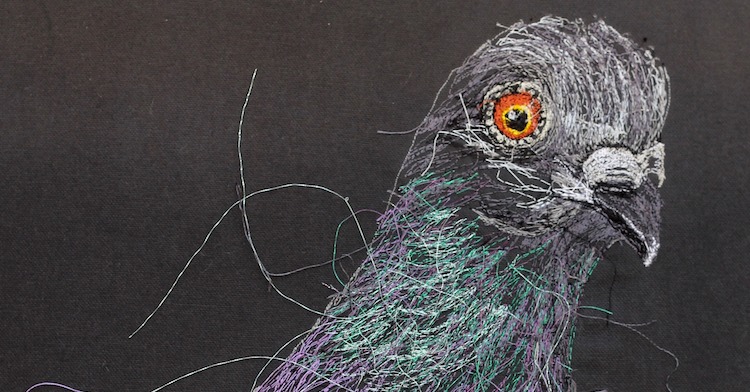
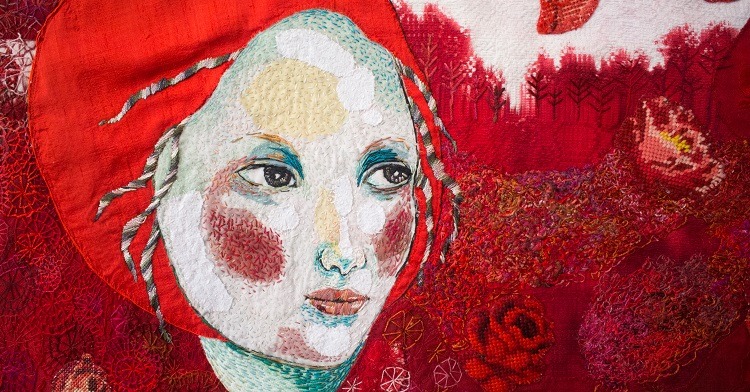
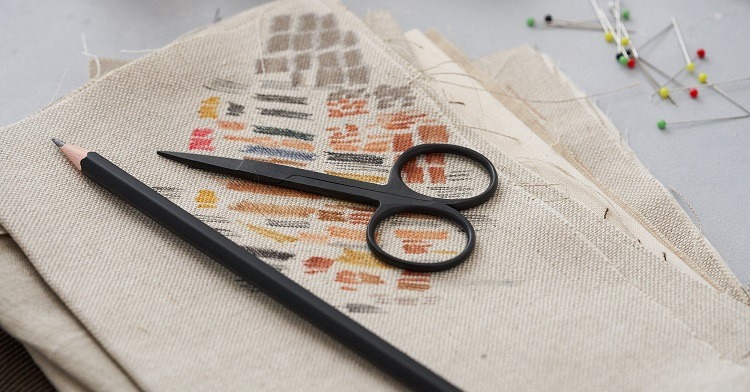
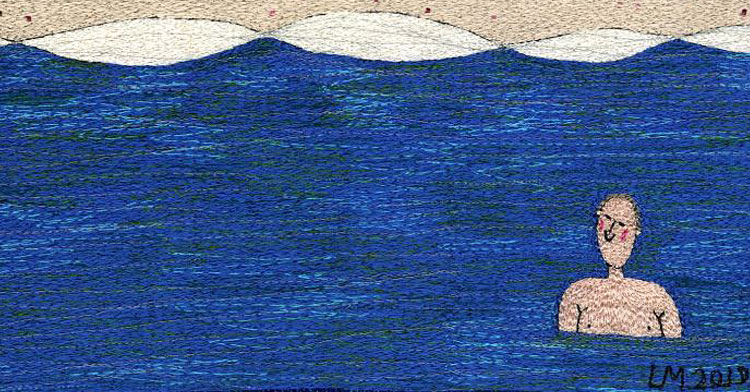

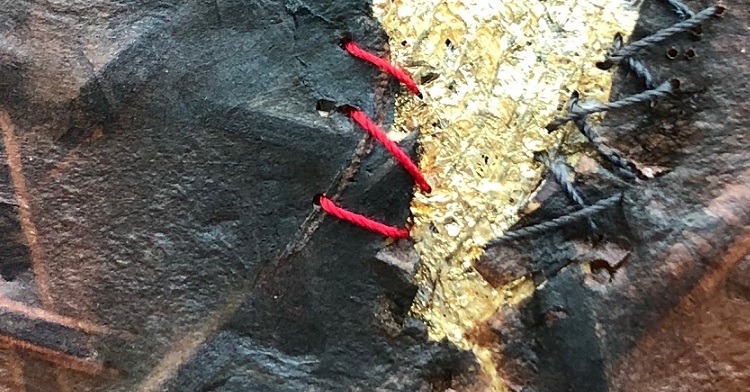
1 comment